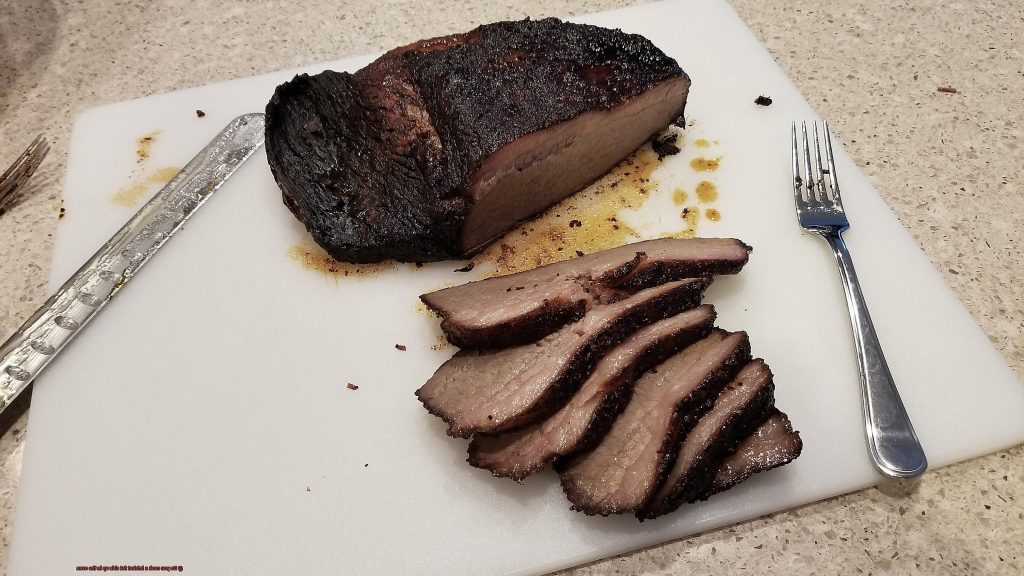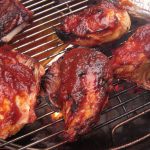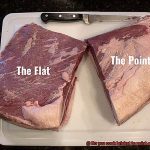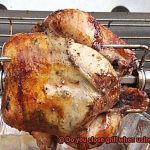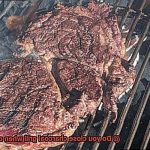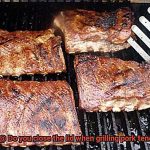Brisket is a dish that’s as much about tradition as it is about taste. It’s a cut of meat that’s been slow-cooked to perfection in Southern kitchens for generations, and now, it’s made its way into the hearts (and stomachs) of foodies around the world.
But when it comes to cooking brisket, there’s one question that seems to divide cooks and pitmasters alike: do you cook a brisket fat side up in the oven? Some say yes, arguing that this method ensures a juicier, more flavorful end result. Others say no, claiming that it doesn’t make any difference at all.
So where does the truth lie? In this blog post, we’re going to explore the ins and outs of cooking brisket fat side up in the oven. We’ll take a deep dive into the science behind this method and look at how the fat cap on top of the meat affects everything from flavor to texture.
But we won’t stop there – we’ll also examine some of the other factors that go into making a perfect brisket. From seasoning to smoke to temperature control, there are plenty of variables that can make or break your brisket.
Whether you’re an experienced pitmaster or just starting out on your culinary journey, this blog post will give you all the information you need to cook a delicious brisket with confidence. So grab your apron and fire up your oven – it’s time to get cooking.
Contents
What is a Brisket?
Brisket is a large cut of beef that comes from the lower chest of a cow. This tough and fibrous muscle requires low and slow cooking to become tender and juicy.
When it comes to brisket, there are two parts to it: the point and the flat. The point is the thicker, fattier end of the brisket, while the flat is leaner and thinner. But that’s not all – there’s also a layer of fat on top of the brisket, known as the fat cap, which can be a topic of debate for pitmasters everywhere.
Some argue that cooking brisket with the fat side up allows the fat to melt and baste the meat as it cooks, resulting in a more tender and flavorful brisket. Others prefer to cook it with the fat side down, believing that it allows for better smoke penetration into the meat. Ultimately, it comes down to personal preference.
When purchasing brisket, you have two options: trimmed or untrimmed. A trimmed brisket will have less fat on it, making it easier to handle during cooking. An untrimmed brisket will have more fat, which adds flavor and moisture but requires more attention during cooking.
What is the Fat Cap on a Brisket?
Today, we’re going to delve into the highly debated topic of the fat cap on a brisket. This layer of fat covers one side of the meat, and its thickness can vary from ¼ to ½ inch. But what does it do?
Some pitmasters swear that cooking a brisket with the fat cap on top helps keep the meat moist and flavorful. Others argue that placing the fat cap on the bottom allows for more even penetration of the juices.
The choice is yours, but it’s important to know that not all briskets come with a fat cap. Some butchers may trim it off completely, while others may leave it on but reduce its thickness.
When purchasing your brisket, make sure to ask about the presence and thickness of the fat cap. If you decide to cook your brisket with the fat cap on top, scoring is essential. Scoring means cutting shallow cross-hatches into the fat layer, which allows the fat to render down and baste the meat as it cooks. Failure to score the fat may result in a tough and chewy brisket.
The fat cap debate rages on, but what’s most important is ensuring that your brisket reaches a safe internal temperature of at least 165°F (74°C) and is rested for at least 15 minutes before slicing. To sum up, here are some key takeaways:
- The fat cap is a layer of fat covering one side of the brisket.
- Its thickness can vary from ¼ to ½ inch.
- Not all briskets have a fat cap.
- Cooking with the fat cap up or down is a matter of personal preference.
- Scoring the fat before cooking is crucial for optimal flavor.
- Ensure your brisket reaches a safe internal temperature before serving.
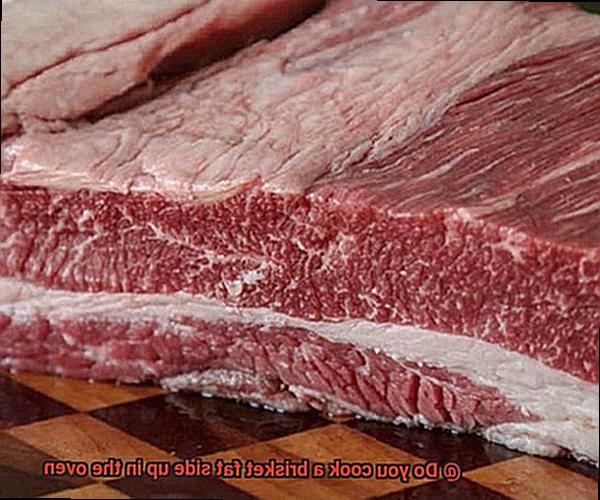
Pros of Cooking a Brisket with the Fat Side Up
Brisket cooking is an art, and there are many ways to do it right. However, when it comes to the age-old debate of whether to cook a brisket with the fat side up or down, the answer is clear – go with the fat side up. Here’s why:
Firstly, cooking a brisket with the fat side up is a game-changer for flavor and texture. As the fat slowly renders and melts into the meat, it imparts a rich, savory taste while keeping the meat moist and juicy. No more dry or tough brisket that leaves your guests disappointed.
But that’s not all – the rendered fat also acts as a protective barrier between the meat and the heat source, preventing it from becoming too dry or overcooked. This means you can cook your brisket low and slow without worrying about ruining it.
Another advantage of cooking a brisket with the fat side up is that it promotes even cooking throughout the meat. Heat rises, so placing the fat side up allows for more consistent distribution of heat, resulting in a perfectly cooked brisket every time.
And let’s not forget about the visual appeal. The rendered fat creates a beautiful crust on top of the meat that is both flavorful and aesthetically pleasing. Your guests will be impressed by your culinary skills before they even take a bite.
Cons of Cooking a Brisket with the Fat Side Up
When it comes to cooking a brisket, there’s a lot of debate around whether to cook it with the fat side up or down. While the idea of letting the fat melt and baste the meat might sound good in theory, there are actually several cons to consider before making your decision.
Firstly, one of the most significant issues with cooking a brisket with the fat side up is that it can lead to an excessively greasy end result. As the fat renders and accumulates on top of the meat, it can make it unappetizing and difficult to slice neatly. So, if you’re looking for a leaner, more visually appealing brisket, cooking with the fat side down may be a better choice.
Another problem with cooking with the fat side up is that it can result in uneven cooking. The fat acts as an insulator and can cause some parts of the meat to cook more slowly and unevenly than others. This means you could end up with an overcooked, tough brisket that’s not very enjoyable to eat.
In addition to uneven cooking, when you cook a brisket with the fat side up, it can also be harder to achieve a good bark on the outside. The bark is what gives a brisket its crispy, flavorful crust, and when the fat is on top, it can prevent direct contact between the heat source and meat. This means that your brisket may not have that delicious crunch that many people love.
Lastly, cooking with the fat side up can result in an unattractive presentation. The melted fat on top of the meat can create an unappealing appearance and make it less visually appealing for serving. If you’re looking for a beautiful, Instagram-worthy brisket, this approach may not be your best bet.
Pros of Cooking a Brisket with the Fat Side Down
Then, it’s time to master the art of cooking a delicious brisket. But before you fire up your oven or smoker, there’s a crucial decision to make: should you cook with the fat side up or down? While both methods have their merits, let’s explore the pros of cooking a brisket with the fat side down.
First and foremost, cooking with the fat side down allows for better bark formation. The bark is the coveted crust on the outside of the meat that is packed with flavor and texture. By having the meat come into direct contact with the heat source, you can achieve an even and crispy bark that will take your brisket to the next level. It’s like a savory armor that protects and enhances the succulent meat inside.
Another advantage of cooking with the fat side down is that it helps preserve moisture and flavor in the meat. As the brisket cooks, the fat will render and melt into the meat, creating a juicy and flavorful masterpiece. However, if you cook with the fat side up, all that deliciousness can easily drip away from the meat and be lost during cooking. In other words, cooking with the fat side down ensures that every bite is bursting with taste bud-tingling goodness.
In addition, cooking with the fat side down can help prevent flare-ups in your oven or smoker. The rendered fat can potentially cause flare-ups if it comes into contact with an open flame or heating element. By keeping the fat side down, you can avoid these potential hazards and ensure that your brisket cooks evenly without any surprises.
Last but not least, cooking with the fat side down makes slicing and serving your brisket a breeze. Since the fat will have melted into the meat during cooking, it won’t interfere with clean slices and presentation. Instead, you can showcase your culinary skills and impress your guests with a beautifully sliced and juicy brisket that’s sure to please.
Cons of Cooking a Brisket with the Fat Side Down
Though it may seem like a good idea to encase your meat in a protective layer of fat, this method can actually result in a less-than-ideal finished product.
First and foremost, cooking a brisket with the fat side down can lead to dryness and toughness. The juices from the meat are unable to penetrate through the layer of fat, leaving your brisket lacking in both flavor and moisture. And let’s be honest – no one wants a dry and bland piece of brisket.
Additionally, cooking with the fat side down can cause uneven cooking throughout the brisket. The heat has to work its way through the layer of fat before reaching the meat, which can cause certain areas to be overcooked while others remain undercooked. This results in an inconsistent texture throughout the brisket, which is not what you want when serving up a delicious meal.
Finally, cooking with the fat side down can make it difficult to achieve that coveted crispy bark on top of your brisket. The layer of fat acts as a barrier between the meat and any seasoning or rub applied to the surface, preventing it from fully penetrating and creating that desired crust.
Although there may be some visual benefits to cooking with the fat side down (such as better presentation), these advantages are outweighed by the potential drawbacks. In general, most experts recommend cooking with the fat side up for optimal results.
So if you’re looking to cook up a flavorful and mouth-watering brisket, consider flipping that bad boy over and letting that beautiful fat cap work its magic on top of your meat. Your taste buds will thank you for it.
In summary, here are the cons of cooking a brisket with the fat side down:
Tips for Perfectly Cooked Briskets
For the best results, choose a brisket that is well-marbled with fat. This will help keep the meat moist and tender during cooking. When picking a brisket from the meat counter, look for one that has a good balance of fat and meat.
Consider the Cooking Method
While traditionalists may prefer to cook their brisket on a grill or smoker, it’s possible to achieve great results in the oven too. When cooking in the oven, it’s generally recommended to cook the brisket fat side up. This allows the fat to render down into the meat, adding flavor and moisture throughout.
Use a Rub or Marinade
To add extra flavor to your brisket, use a rub or marinade. A simple mixture of salt, pepper, and garlic powder can enhance the natural flavors of the meat. Experiment with different spices and herbs to find your favorite combination.
Be Patient
Brisket requires a long, slow cooking process in order to become tender and flavorful. Depending on the size of your brisket, you may need to cook it for several hours or even overnight.
To ensure that your brisket is perfectly cooked, use a meat thermometer to check the internal temperature of the meat. The ideal temperature for brisket is around 195-205°F.
Let it Rest
After cooking, let your brisket rest for at least 10-15 minutes before slicing and serving. This allows the juices to redistribute throughout the meat, resulting in a more tender and flavorful final product. Cover it with foil while resting to keep it warm.
a11fEy_FAeQ” >
Conclusion
In the world of cooking, few things are as revered as a perfectly cooked brisket. And while there are many factors that go into creating this culinary masterpiece, one question reigns supreme: do you cook a brisket fat side up in the oven?
After much debate and consideration, it seems that the answer is a resounding yes. Cooking with the fat side up not only results in a juicier, more flavorful brisket, but also ensures an even distribution of heat throughout the meat. And let’s not forget about scoring the fat – a crucial step for achieving optimal flavor.
On the other hand, cooking with the fat side down can lead to dryness and toughness in the meat. Plus, it makes it difficult to achieve that coveted crispy bark on top.
But cooking a perfect brisket isn’t just about which way you position it in the oven. Choosing the right cut of meat, considering your preferred cooking method, using a rub or marinade, being patient during cooking time and letting it rest before slicing are all important factors.
So, whether you’re hosting a backyard barbecue or simply looking to impress your family with your culinary skills, remember that finding your own personal preferences and experimenting with different techniques is key to creating your perfect brisket recipe.

